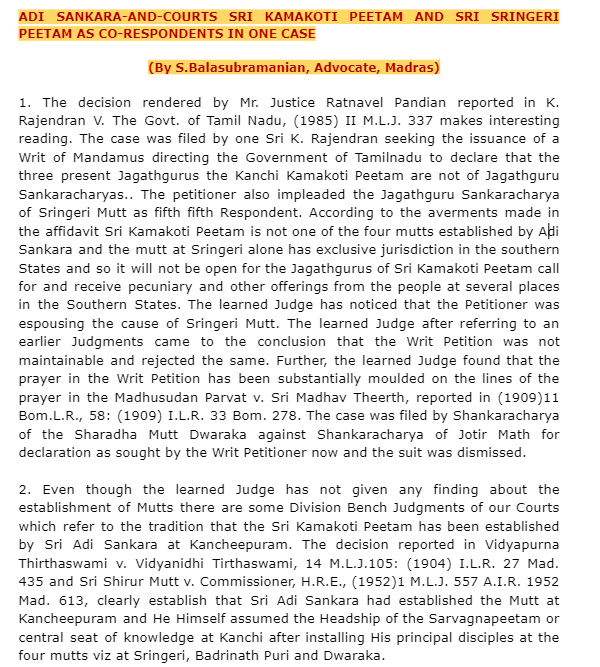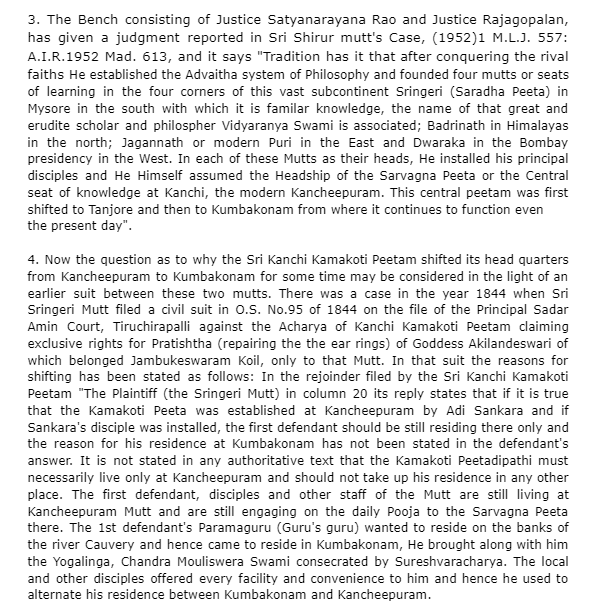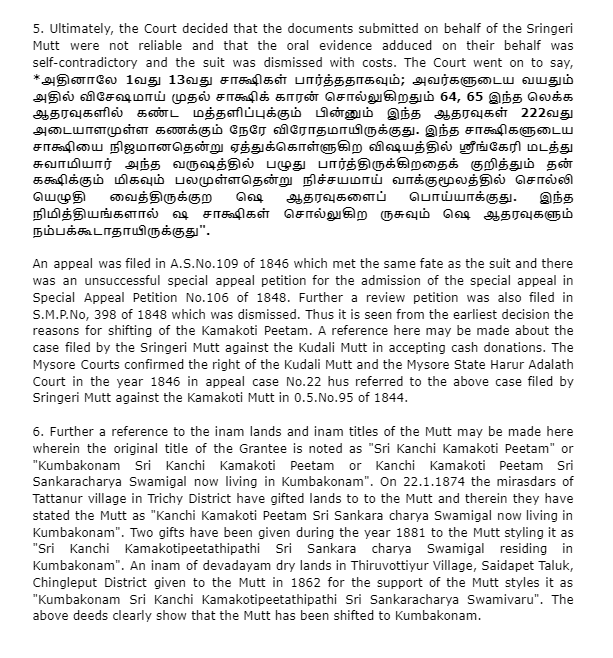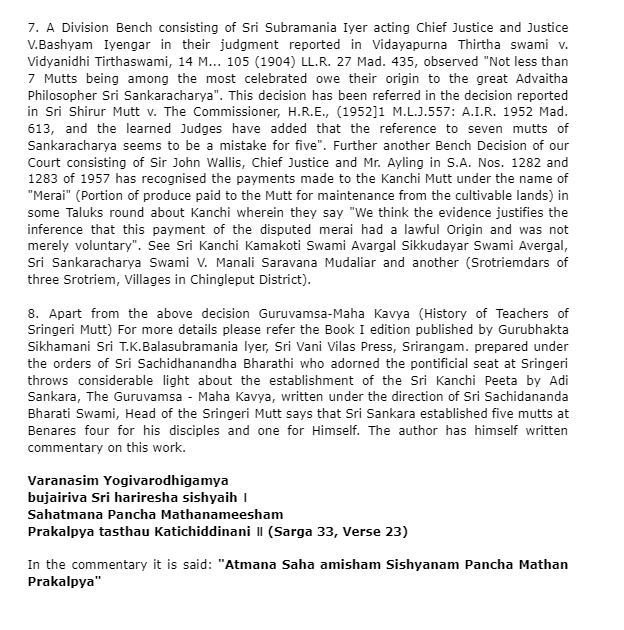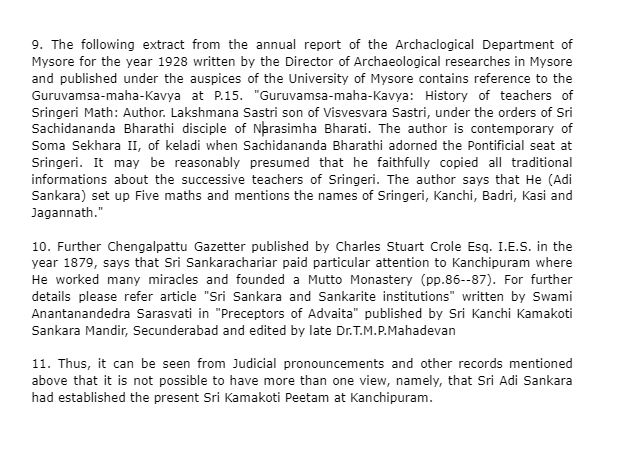Many ancient maṭhas were established as independent entities with their own traditions, purposes, and spiritual lineages. Recent claims of the Tunga maṭha, referring to Kudali, Shivaganga and Amani and other maṭhas as their “branches” (śākhā maṭhas) lack any historical or scriptural basis (pramāṇa).These baseless claims, often linked to an attempt to centralize authority, are rooted in religious expansionist ideologies. They also undermine the independence and diversity of these ancient maṭhas, which have traditionally functioned as autonomous religious institutions.Courts have consistently dismissed such assertions, citing insufficient evidence and affirming the independence of maṭhas. Further, imposing hierarchical dominance through false claims violates Articles 25 and 26 of the Indian Constitution, which protect Religious Freedom and the Right of these Independant Religious Denominations to govern themselves.
Category: Legal
FAQs – Mathamnaya Judicial Precedent
Mathamnaya..2
Q: What is the earliest recorded judicial precedent on this particular issue (Mathamnaya) ?
In the case of Shri Madhusudan Parvat of Jyotir matha, the Bombay High Court held,
A: 1.” Mathamnaya on which the Plaintiff (in the lower court) relles is not a work of Shankar Mathamnayas contain traditional ideals and could not have come down from Shankar”. (page 62).
2. “There is no authoritative version of the Mathamnaya and witnesses for the defendant (in the Lower Court) have produced other versions of it which differ in material particulars from those relied upon by the plaintiff “. (page 66).
3. “If there ever was any strict reservation of areas for the Mohunts of the various Maths certain facts proved in the case indicate that the reservation has long been disregarded.” (page 67)
[Shree Madhusudhan Parvat (Shankaracharya of Jyotir Math) Appellant (Defendant in Lower Court) Vs. Shree Madhav Teerth (Shankaracharya of Dwaraka Math) Respondent (Plaintiff in Lower Court).(Vol. XI of the Bombay Law Reporter)
First Appeal No. 45 of 1907, from the decree passed by Chandulal Mathurdas, Esq., First Class Subordinate Judge at Ahmedabad in Civil Suit No, 640 of 1904.
Before the Honourable Mr. Basil Scott, Chief Justice and Hon. Justice Mr. Batchelor November 11, 1908.]
ADI SANKARA-AND-COURTS – Sri Kamakoti Peetam and Sri Sringeri Peetam as co-respondents in one case
“It is not possible to have more than one view, namely, that Sri Adi Sankara had established the present Sri Kamakoti Peetam at Kanchipuram.”
ADI SANKARA-AND-COURTS
SRI KAMAKOTI PEETAM AND SRI SRINGERI PEETAM
AS CO-RESPONDENTS IN ONE CASE
S.Balasubramanian, Advocate, Madras.
1986 MLJ 9 (Vol.II)
1. The decision rendered by Mr. Justice Ratnavel Pandian reported in K.Rajendran V. The Govt. of Tamil Nadu, (1985) II M.L.J. 337 makes interesting reading. The case was filed by one Sri K.Rajendran seeking the issuance of a Writ of Mandamus directing the Government of Tamilnadu to declare that the three present Jagathgurus of the Kanchi Kamakoti Peetam are not of Jagathguru Sankaracharyas. The petitioner also impleaded the Jagathguru Sankaracharya of Sringeri Mutt as fifth Respondent.
According to the averments made in the affidavit Sri Kamakoti Peetam is not one of the four mutts established by Adi Sankara and the mutt at Sringeri alone has exclusive jurisdiction in the southern States and so it will not be open for the Jagathgurus of Sri Kamakoti Peetam call for and receive pecuniary and other offerings from the people at several places in the Southern States.
The learned Judge has noticed that the Petitioner was espousing the cause of Sringeri Mutt. The learned Judge after referring to an earlier Judgments came to the conclusion that the Writ Petition was not maintainable and rejected the same. Further, the learned Judge found that the prayer in the Writ Petition has been substantially moulded on the lines of the prayer in the Bombay decision in Madhusudan Parvat v. Sri Madhav Theerth, reported in (1909)11 Bom.L.R., 58: (1909) I.L.R. 33 Bom. 278. The case was filed by Shankaracharya of the Sharadha Mutt Dwaraka against Shankaracharya of Jyotir Math for declaration as sought by the Writ Petitioner now and the suit was dismissed.
2. Even though the learned Judge has not given any finding about the establishment of the Mutts there are some Division Bench Judgments of our Courts which refer to the tradition that the Sri Kamakoti Peetam has been established by Sri Adi Sankara at Kancheepuram. The decision reported in Vidayapurna Thirthaswami v. Vidyanidhi Tirthaswami, 14 M.L.J.105: (1904) I.L.R. 27 Mad. 435 and Sri Shirur Mutt v. The Commissioner, H.R.E., (1952)1 M.L.J. 557 A.I.R. 1952 Mad. 613, clearly establish that Sri Adi Sankara had established the Mutt at Kancheepuram and He Himself assumed the Headship of the Sarvagna peetam or central seat of knowledge at Kanchi after installing His principal disciplies at the four mutts viz at Sringeri, Badrinath, Puri and Dwaraka.
3. The Bench consisting of Justice Satyanarayana Rao and Justice Rajagopalan, has given a judgment reported in Sri Shirur mutt’s Case, (1952)1 M.L.J. 557: A.I.R.1952 Mad. 613, and it says “Tradition has it that after conquering the rival faiths He established the Advaita system of Philosophy and founded four mutts or seats of learning in the four corners of this vast subcontinent Sringeri (Saradha Peeta) in Mysore in the south with which it is familar knowledge, the name of that great and erudite scholar and philospher Vidyaranya Swami is associated; Badrinath in Himalayas in the north; Jagannath or modern Puri in the East and Dwaraka in the Bombay presidency in the West. In each of these Mutts as their heads, He installed his principal disciples and He Himself assumed the Headship of the Sarvagna Peeta or the Central seat of knowledge at Kanchi, the modern Kancheepuram. This central peetam was first shifted to Tanjore and then to Kumbakonam from where it continues to function even in the present day”.
4. Now the question as to why the Sri Kanchi Kamakoti Peetam shifted its head quarters from Kancheepuram to Kumbakonam for some time may be considered in the light of an earlier suit between these two mutts. There was a case in the year 1844 when Sri Sringeri Mutt filed a civil suit in O.S.No.95 of 1844 on the file of the Principal Sadar Amin Court, Tiruchirapalli against the Acharya of Kanchi Kamakoti Peetam claiming exclusive rights for Pratishtha (repairing the the ear rings) of Goddess Akilandeswari of which belonged Jambukeswaram Koil, only to that Mutt.
In that suit the reasons for shifting has been stated as follows: In the rejoinder filed by the Sri Kanchi Kamakoti Peetam “The Plaintiff (the Sringeri Mutt) in column 20 its reply states that if it is true that the Kamakoti Peeta was established at Kancheepuram by Adi Sankara and if Sankara’s disciple was installed, the first defendant should be still residing there only and the reason for his residence at Kumbakonam has not been stated in the defendant’s answer. It is not stated in any authoritative text that the Kamakoti Peetadipathi must necessarily live only at Kancheepuram and should not take up his residence in any other place. The first defendant, disciples and other staff of the Mutt are still living at Kancheepuram Mutt and are still engaging on the daily Pooja to the Sarvagna Peeta there. The 1st defendant’s Paramaguru (Guru’s guru) wanted to reside on the banks of the river Cauvery and hence came to reside in Kumbakonam. He brought along with him the Yogalinga, Chandra Mouliswera Swami consecrated by Sureshvaracharya. The local and other disciples offered every facility and convenience to him and hence he used to alternate his residence between Kumbakonam and Kancheepuram.
5. Ultimately, the Court decided that the documents submitted on behalf of the Sringeri Mutt were not reliable and that the oral evidence adduced on their behalf was self-contradictory and the suit was dismissed with costs. The Court went on to say,
“அதினாலே 1வது 13வது சாக்ஷிகள் பார்த்ததாகவும்: அவர்களுடைய வயதும் அதில் விசேஷமாய் முதல் சாக்ஷிக் காரன் சொல்லுகிறதும் 64, 65 இந்த லெக்க ஆதரவுகளில் கண்ட மத்தளிப்புக்கும் பின்னும் இந்த ஆதரவுகள் 222வது அடையாளமுள்ள கணக்கும் நேரே விரோதமாயிருக்குது. இந்த சாக்ஷிகளுடைய சாக்ஷியை நிஜமானதென்று ஏத்துக்கொள்ளுகிற விஷயத்தில் ஸ்ரீங்கேரி மடத்து சுவாமியார் அந்த வருஷத்தில் பழுது பார்த்திருக்கிறதைக் குறித்தும் தன் கக்ஷிக்கும் மிகவும் பலமுள்ளதென்று நிச்சயமாய் வாக்குமூலத்தில் சொல்லி யெழுதி வைத்திருக்குற ஷெ ஆதரவுகளைப் பொய்யாக்குது. இந்த நிமித்தியங்களால் ஷ சாக்ஷிகள் சொல்லுகிற ருசுவும் ஷெ ஆதரவுகளும் நம்பக்கூடாதாயிருக்குது:”
An appeal was filed in A.S.No.109 of 1846 which met the same fate as the suit and there was an unsuccessful special appeal petition for the admission of the special appeal in special appeal Petition No.106 of 1848. Further a review petition was also filed in S.M.P.No. 398 of 1848 which was dismissed. Thus it is seen from the earliest decision the reasosns for shifting of the Kamakoti Peetam. A reference here may be made about the case filed by the Sringeri Mutt against the Kudali Mutt in accepting cash donations. The Mysore Courts confirmed the right of the Kudali Mutt and the Mysore State Hazur Adalath Court in the year 1846 in appeal case No.22 has referred to the above case filed by Sringeri Mutt against the Kamakoti Mutt in O.S.No.95 of 1844.
6. Further a reference to the inam lands and inam titles of the Mutt may be made here wherein the original title of the Grantee is noted as “Sri Kanchi Kamakoti Peetam” or “Kumbakonam Sri Kanchi Kamakoti Peetam or Kanchi Kamakoti Peetam Sri Sankaracharya Swamigal now living in Kumbakonam”.
On 22.1.1874 the mirasdars of Tattanur village in Trichy District have gifted lands to to the Mutt and therein they have stated the Mutt as “Kanchi Kamakoti Peetam Sri Sankara charya Swamigal now living in Kumbakonam”.
Two gifts have been given during the year 1881 to the Mutt styling it as “Sri Kanchi Kamakoti peetadhipathi Sri Sankaracharya Swamigal residing in Kumbakonam”.
An inam of devadayam dry lands in Thiruvottiyur Village, Saidapet Taluk, Chingleput District given to the Mutt in 1862 for the support of the Mutt styles it as “Kumbakonam Sri Kanchi Kamakoti peetathipathi Sri Sankaracharya Swamivaru”. The above deeds clearly show that the Mutt has been shifted to Kumbakonam.
7. A Division Bench consisting of Sri Subramania Iyer acting Chief Justice and Justice V.Bashyam Iyengar in their judgment reported in Vidayapurna Thirtha swami v. Vidyanidhi Tirthaswami, 14 M.L.J. 105 (1904) L.L.R. 27 Mad. 435, observed “Not less than 7 Mutts being among the most celebrated owe their origin to the great Advaitha Philosopher Sri Sankaracharya”.
This decision has been referred in the decision reported in Sri Shirur Mutt v. The Commissioner, H.R.E., (1952)1 M.L.J. 557: A.I.R. 1952 Mad. 613, and the learned Judges have added that the reference to seven mutts of Sankaracharya seems to be a mistake for five”.
Further another Bench Decision of our Court consisting of Sir John Wallis, Chief Justice and Mr. Ayling in S.A.Nos. 1282 and 1283 of 1957 has recognised the payments made to the Kanchi Mutt under the name of “Merai” (Portion of produce paid to the Mutt for maintenance from the cultivable lands) in some Taluks round about Kanchi wherein they say “We think the evidence justifies the inference that this payment of the disputed merai had a lawful Origin and was not merely voluntary”. See Sri Kanchi Kamakoti Swami Avargal Sikkudayar Swami Avergal, Sri Sankaracharya Swami V. Manali Saravana Mudaliar and another (Srotriemdars of three Srotriem, Villages in Chingleput District).
8. Apart from the above decision Guruvamsa Maha-Kavya (History of Teacher of Sringeri Mutt) For more details please refer the Book I edition published by Guru-bhakta Sikhamani Sri T.K.Balasubramania Iyer, Sri vani vilas Press, Srirangam. prepared under the orders of Sri Sachidhanandha Bharathi who adorned the pontificial seat at Sringeri throws considerable light about the establishment of the Sri Kanchi Peeta by Adi Sankara.
The Guruvamsa Maha Kavya, written under the direction of Sri Sachidananda Bharati Swami, Head of the Sringeri Mutt says that Sri Sankara established five mutts at Benares four for his disciples and one for Himself. The author has himself written commentary on this work.
” Varanasim Yogivaro ‘dhigamya
bujairiva Sri hariresha sishyaih
Sahatmana Pancha Mathanamesham
Prakalpya tasthau Katichiddinani”
(Sarga 33 Verse 23)
In the commentary it is said:
“Atmana Saha amisham Sishyanam Pancha Matham Prakalpya”
The following extract from the annual report of the Archaclogical Department of Mysore for the year 1928 written by the Director of Archaeological researches in Mysore and published under the auspices of the University of Mysore contains reference to the Guruvamsa -maha-Kavya at P.15.
9. ” Guruvamsa-maha-Kavya: History of teachers of Sringeri Math: Author. Laksh mana Sastri son of Visvesvara Sastri, under the orders of Sri Sachidananda Bharathi disciple of Sri Narasimha Bharati. The author is contemporary of Soma Sekhara II, of Keladi when Sachidananda Bharathi adorned the Pontificial seat at Sringeri. It may be reasonably presumed that he faithfully copied all traditional informations about the successive teachers of Sringeri.
The author says that He (Adi Sankara) set up Five maths and mentions the names of Sringeri, Kanchi, Badri, Kasi and Jagannath.”
10. Further Chengalpattu Gazetter published by Charles Stuart Crole Esq. I.E.S. in the year 1879, says that Sri Sankarachariar paid particular attention to Kanchipuram where He worked many miracles and founded a Mutt or Monastery (pp.86–87). For further details please refer article “Sri Sankara and Sankarite institutions” written by Swami Anantanandedra Sarasvati in “Preceptors of Advaita” published by Sri Kanchi Kamakoti Sankara Mandir, Secunderabad and edited by late Dr. T.M.P.Mahadevan.
11. Thus, it can be seen from Judicial pronouncements and other records mentioned above that it is not possible to have more than one view, namely, that Sri Adi Sankara had established the present Sri Kamakoti Peetam at Kanchipuram.
Mahant Bhagawan Shagat vs. Girijanandan Bhagat
Where oral and documentary evidence shows that in the matter of nomination of successor or to a Mahantship seniority is not decisive factor but that heredity and efficiency in management coupled with good moral character and adherence to the religious rites practised at the Math and a spirit of service etc., it is for the person claiming the Mahantship to prove competence.
(Mahant Bhagawan Shagat vs. Girijanandan Bhagat, (1972) 2 SCJ 730; AIR 1972 SC 814)
1986 MLJ 9 (Vol. II)
ADI SANKARA-AND-COURTS : SRI KAMAKOTI PEETAM AND SRI SRINGERI PEETAM AS CO-RESPONDENTS IN ONE CASE
By S.Balasubramanian, Advocate, Madras.
“…. Thus, it can be seen from Judicial pronouncements and other records mentioned above that it is not possible to have more than one view, namely, that Sri Adi Sankara had established the present Sri Kamakoti Peetam at Kanchipuram”.
1986 Madras Law Journal
